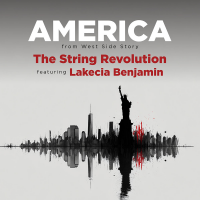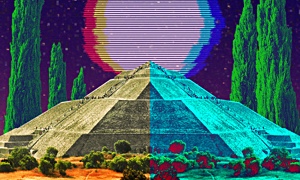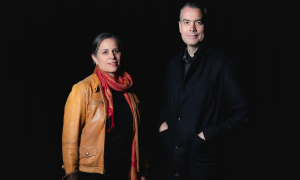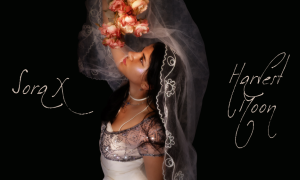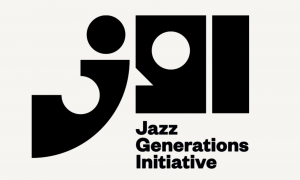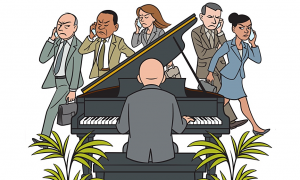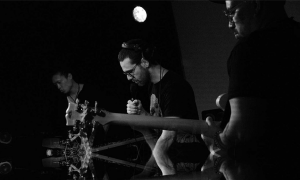Crossover is an interesting word that provokes a number of different reactions in people. On the one hand, it signifies the ultimate goal of any musician—to seamlessly cross between styles and connect with a multitude of artists. Individuals with the unique insight to see the connection points between musical boundaries find themselves with more opportunities and a world of creativity. Other people view crossing over as a commercial act that sacrifices the integrity of musical styles for financial gain. This is a distinctly different act that involves making artistic concessions to reach a wider audience. The true power of the word lies in connections though—the movement between cultural aesthetics and genre definitions.
Composer Roberto Sierra has spent a lifetime crossing between musical worlds and bringing together the ideas of different cultures. Born in Puerto Rico, Sierra grew up studying classical piano and listening to salsa swirling around him. He dove deeper into classical piano at the island's conservatory before deciding that his future should be focused upon composition. Sierra left Puerto Rico to study composition, first in London and later in Hamburg, Germany. He connected with influential composer György Ligeti, soaking up the experienced artist's knowledge while sharing his background in Caribbean music. After a move to the United States, Sierra built his reputation with highly regarded pieces like “Missa Latina" and “Júbilo." An opportunity to see saxophonist James Carter perform inspired Sierra to write a jazz inspired piece, so he approached Carter for a collaboration. The saxophonist agreed, so Sierra began writing what would become “Concerto For Saxophones And Orchestra." Carter and Sierra worked together to find an approach to the piece that held the integrity of Latin and classical music while naturally integrating jazz improvisation. The insight of the two musicians proved poignant and the 2002 premiere of “Concerto For Saxophones And Orchestra" awed the audience. Sierra and Carter decided to record the piece in Poland with conductor Giancarlo Guerrero. Another Sierra composition rounded out the album—"Caribbean Rhapsody," a tribute to his memories of popular music in Puerto Rico. Carter was joined on the piece by his musical cousin, violinist Regina Carter, and a string ensemble; the full group delivered a powerful performance that captured the essence of son montuno and more. The collection of these pieces, along with some solo saxophone improvisations from Carter produced a stunned album that touches upon many musical realms.
Sierra crosses over in the best sense of the word on Caribbean Rhapsody, touching upon the several musical worlds that have touched his life. His use of classical forms, Caribbean rhythmic traditions, and jazz improvisation honor each style deeply while creating something absolutely unique. His insightful use of these genres appeals to audiences, but it also allows him to collaborate on a high level with Carter, delivering an unforgettable performance. In the first part of our interview with Sierra, we looked at his exposure to salsa and classical music in Puerto Rico, his move towards composition, and his studies with Ligeti. We dug deeply into “Concerto For Saxophones And Woodwinds" in Part Two of our interview, discussing his relationship with Carter and the extent of their collaboration. We conclude our conversation today, talking about “Caribbean Rhapsody," Regina Carter's involvement in the album, and crossing over.
LATIN JAZZ CORNER: James talks about Giancarlo Guerrero as an artistic appendage—why did you bring him into the project and what do you think that his work as a conductor brought into the recording?
ROBERTO SIERRA: He is a fantastic conductor and an amazingly gifted man. I think that he's a great conductor. Not only that, but he also understands rhythm.
LJC: Do you mean the references to Latin rhythms or polyrhythms in general?
RS: You can narrow it to whatever you want, but he understands any rhythm. He understands rhythm from a physical sense. There are people that barely understand rhythm intellectually. In jazz or Caribbean music, anybody can count “one, two, three, one, two, three" or “one, two, one two." That's the intellectual part. That's one thing, but the other thing is to feel it.
The good jazz player is the one that can play that note just a little bit before or after the beat. The one that can get off the main rhythmic pattern in an amazing way and be very complex. It's like what you hear in some salsa, when you hear the sonero Ismael Miranda or La Lupe—when they would go off the main beat it was absolutely stunning. They flowed and then they went back. And they weren't even thinking about it!
LJC: I would think that one of the challenges as a conductor would be expressing that rhythmic feeling and sharing it with the orchestra.
RS: Absolutely. With somebody like James, if the conductor does not have the amazing sensibility that Giancarlo has, it doesn't really work. Then James would feel constrained. He may not say something to the conductor, but you would immediately start to see a discomfort. It wouldn't be any different from him playing in his jazz ensemble. If there is someone who is not with it, it wouldn't work.
LJC: I read that the piece “Caribbean Rhapsody" was inspired by the sounds that you heard growing up in Puerto Rico.
RS: It was jukebox music. These are the memories of jukebox songs. The slow parts come from boleros and the fast parts come from different types of salsa strains.
LJC: Did you have James in mind for this piece as well when you were writing it?
RS: Yea, I wrote it especially for James and Regina Carter.
LJC: What was different that you were trying to capture in “Caribbean Rhapsody" as opposed to “Concerto For Saxophones And Orchestra"?
RS: Although there are Latin elements in “Concerto For Saxophones And Orchestra," I wanted to do more of a purely Latin piece with this one. And it is, as you can hear. I was curious to see what James would do, and James became a salsero! There's also improvisation on this piece, and he improvised like a salsa musician! I don't really know if he's every really played that style or not, but I have no doubt that it would take him two seconds to fit in.
LJC: You hear the bolero in the beginning of the piece, and I thought that I heard some danzon in it . . .
RS: Probably. I was born in 1953, so I'm older. I haven't gotten to Reggaeton yet. My Caribbean roots are from an earlier period! Now I go to Puerto Rico and it's a different thing, it's Reggaeton all the time.
LJC: After the slow section, the piece goes into son montuno—the easy choice would have been to add congas and timbales . . .
RS: I purposely did not want to do it—it was even suggested. We were doing this for the recording and somebody had a fear that just having strings might not do the trick since it was such a small group. I was asked if I wanted to add percussion, and I said, “No, I don't want to add it." It was too obvious. It was exactly for that reason.
LJC: Regina Carter sounds great on “Caribbean Rhapsody"—how did she get involved in the project?
RS: On the logistic side of her involvement, it was her management. I had never met her before and I had never worked with her, so it was a new thing for both of us. The first time that I met her was the rehearsal before the recording. So we didn't really have much of a chance to talk beforehand. But this is what happens when you're dealing with great musicians—they immediately get going. Two hours into working with her—even after not having met before—it was like we had been working all our lives together. The back and forth between her and James was fantastic, fun, and vibrant.
LJC: You stand out as a Caribbean composer in the classical world that is widely known; are there other composers that are doing similar work?
RS: I think that there have been people—not so much from Puerto Rico, but from Cuba. There's Paquito D'Rivera; he does classical, jazz, Afro-Cuban, and he writes music as well. I don't know of a classical composer—I don't say this trying to say anything extraordinary about myself, it's just factual—I don't' know of a classical composer who has written a popular music piece like “Caribbean Rhapsody." If I would detach myself from the picture and act purely as an observer, I would say that popular musicians would not do a popular piece like “Caribbean Rhapsody" either. It mixes the elements equally. A popular musician might do a piece like “Caribbean Rhapsody," but it wouldn't be written, it would be based on lead sheets, and they would have put percussion, electric bass, or something like that in it. The classical composer wouldn't have dealt with the popular element in some of the pure formats that I dealt with it—like the son montuno, the vamps, and all of that. In that way, it's a very experimental piece.
LJC: There's that whole idea of crossover out there—do you have that intention of trying to reach different people or is this just another extension of your work?
RS: I try to reach something within my heart. In that way, I'll reach other people, but I'm trying to look into myself. Crossover is a perfect word because this crosses over and messes things up in a way that I think it should be. The problem with what we think of as crossover is that people consider it wimpy. It's not good in the popular idiom and it's not good in the classical idiom. When you have a rock musician or some jazz musician writing for symphony orchestra, they don't know how to handle the orchestra—and vice versa; when you have a classical musician dealing with popular elements, it sort of mutes it. That's why people say it's wimpy.
LJC: Looking into the future, would you consider bringing together jazz, Latin, and classical again?
RS: Absolutely. You never go back, you go forward. The music that I knew growing up, it's glorious music. Jazz has some of the best things out there ever. Absolutely.
Composer Roberto Sierra has spent a lifetime crossing between musical worlds and bringing together the ideas of different cultures. Born in Puerto Rico, Sierra grew up studying classical piano and listening to salsa swirling around him. He dove deeper into classical piano at the island's conservatory before deciding that his future should be focused upon composition. Sierra left Puerto Rico to study composition, first in London and later in Hamburg, Germany. He connected with influential composer György Ligeti, soaking up the experienced artist's knowledge while sharing his background in Caribbean music. After a move to the United States, Sierra built his reputation with highly regarded pieces like “Missa Latina" and “Júbilo." An opportunity to see saxophonist James Carter perform inspired Sierra to write a jazz inspired piece, so he approached Carter for a collaboration. The saxophonist agreed, so Sierra began writing what would become “Concerto For Saxophones And Orchestra." Carter and Sierra worked together to find an approach to the piece that held the integrity of Latin and classical music while naturally integrating jazz improvisation. The insight of the two musicians proved poignant and the 2002 premiere of “Concerto For Saxophones And Orchestra" awed the audience. Sierra and Carter decided to record the piece in Poland with conductor Giancarlo Guerrero. Another Sierra composition rounded out the album—"Caribbean Rhapsody," a tribute to his memories of popular music in Puerto Rico. Carter was joined on the piece by his musical cousin, violinist Regina Carter, and a string ensemble; the full group delivered a powerful performance that captured the essence of son montuno and more. The collection of these pieces, along with some solo saxophone improvisations from Carter produced a stunned album that touches upon many musical realms.
Sierra crosses over in the best sense of the word on Caribbean Rhapsody, touching upon the several musical worlds that have touched his life. His use of classical forms, Caribbean rhythmic traditions, and jazz improvisation honor each style deeply while creating something absolutely unique. His insightful use of these genres appeals to audiences, but it also allows him to collaborate on a high level with Carter, delivering an unforgettable performance. In the first part of our interview with Sierra, we looked at his exposure to salsa and classical music in Puerto Rico, his move towards composition, and his studies with Ligeti. We dug deeply into “Concerto For Saxophones And Woodwinds" in Part Two of our interview, discussing his relationship with Carter and the extent of their collaboration. We conclude our conversation today, talking about “Caribbean Rhapsody," Regina Carter's involvement in the album, and crossing over.
LATIN JAZZ CORNER: James talks about Giancarlo Guerrero as an artistic appendage—why did you bring him into the project and what do you think that his work as a conductor brought into the recording?
ROBERTO SIERRA: He is a fantastic conductor and an amazingly gifted man. I think that he's a great conductor. Not only that, but he also understands rhythm.
LJC: Do you mean the references to Latin rhythms or polyrhythms in general?
RS: You can narrow it to whatever you want, but he understands any rhythm. He understands rhythm from a physical sense. There are people that barely understand rhythm intellectually. In jazz or Caribbean music, anybody can count “one, two, three, one, two, three" or “one, two, one two." That's the intellectual part. That's one thing, but the other thing is to feel it.
The good jazz player is the one that can play that note just a little bit before or after the beat. The one that can get off the main rhythmic pattern in an amazing way and be very complex. It's like what you hear in some salsa, when you hear the sonero Ismael Miranda or La Lupe—when they would go off the main beat it was absolutely stunning. They flowed and then they went back. And they weren't even thinking about it!
LJC: I would think that one of the challenges as a conductor would be expressing that rhythmic feeling and sharing it with the orchestra.
RS: Absolutely. With somebody like James, if the conductor does not have the amazing sensibility that Giancarlo has, it doesn't really work. Then James would feel constrained. He may not say something to the conductor, but you would immediately start to see a discomfort. It wouldn't be any different from him playing in his jazz ensemble. If there is someone who is not with it, it wouldn't work.
LJC: I read that the piece “Caribbean Rhapsody" was inspired by the sounds that you heard growing up in Puerto Rico.
RS: It was jukebox music. These are the memories of jukebox songs. The slow parts come from boleros and the fast parts come from different types of salsa strains.
LJC: Did you have James in mind for this piece as well when you were writing it?
RS: Yea, I wrote it especially for James and Regina Carter.
LJC: What was different that you were trying to capture in “Caribbean Rhapsody" as opposed to “Concerto For Saxophones And Orchestra"?
RS: Although there are Latin elements in “Concerto For Saxophones And Orchestra," I wanted to do more of a purely Latin piece with this one. And it is, as you can hear. I was curious to see what James would do, and James became a salsero! There's also improvisation on this piece, and he improvised like a salsa musician! I don't really know if he's every really played that style or not, but I have no doubt that it would take him two seconds to fit in.
LJC: You hear the bolero in the beginning of the piece, and I thought that I heard some danzon in it . . .
RS: Probably. I was born in 1953, so I'm older. I haven't gotten to Reggaeton yet. My Caribbean roots are from an earlier period! Now I go to Puerto Rico and it's a different thing, it's Reggaeton all the time.
LJC: After the slow section, the piece goes into son montuno—the easy choice would have been to add congas and timbales . . .
RS: I purposely did not want to do it—it was even suggested. We were doing this for the recording and somebody had a fear that just having strings might not do the trick since it was such a small group. I was asked if I wanted to add percussion, and I said, “No, I don't want to add it." It was too obvious. It was exactly for that reason.
LJC: Regina Carter sounds great on “Caribbean Rhapsody"—how did she get involved in the project?
RS: On the logistic side of her involvement, it was her management. I had never met her before and I had never worked with her, so it was a new thing for both of us. The first time that I met her was the rehearsal before the recording. So we didn't really have much of a chance to talk beforehand. But this is what happens when you're dealing with great musicians—they immediately get going. Two hours into working with her—even after not having met before—it was like we had been working all our lives together. The back and forth between her and James was fantastic, fun, and vibrant.
LJC: You stand out as a Caribbean composer in the classical world that is widely known; are there other composers that are doing similar work?
RS: I think that there have been people—not so much from Puerto Rico, but from Cuba. There's Paquito D'Rivera; he does classical, jazz, Afro-Cuban, and he writes music as well. I don't know of a classical composer—I don't say this trying to say anything extraordinary about myself, it's just factual—I don't' know of a classical composer who has written a popular music piece like “Caribbean Rhapsody." If I would detach myself from the picture and act purely as an observer, I would say that popular musicians would not do a popular piece like “Caribbean Rhapsody" either. It mixes the elements equally. A popular musician might do a piece like “Caribbean Rhapsody," but it wouldn't be written, it would be based on lead sheets, and they would have put percussion, electric bass, or something like that in it. The classical composer wouldn't have dealt with the popular element in some of the pure formats that I dealt with it—like the son montuno, the vamps, and all of that. In that way, it's a very experimental piece.
LJC: There's that whole idea of crossover out there—do you have that intention of trying to reach different people or is this just another extension of your work?
RS: I try to reach something within my heart. In that way, I'll reach other people, but I'm trying to look into myself. Crossover is a perfect word because this crosses over and messes things up in a way that I think it should be. The problem with what we think of as crossover is that people consider it wimpy. It's not good in the popular idiom and it's not good in the classical idiom. When you have a rock musician or some jazz musician writing for symphony orchestra, they don't know how to handle the orchestra—and vice versa; when you have a classical musician dealing with popular elements, it sort of mutes it. That's why people say it's wimpy.
LJC: Looking into the future, would you consider bringing together jazz, Latin, and classical again?
RS: Absolutely. You never go back, you go forward. The music that I knew growing up, it's glorious music. Jazz has some of the best things out there ever. Absolutely.







